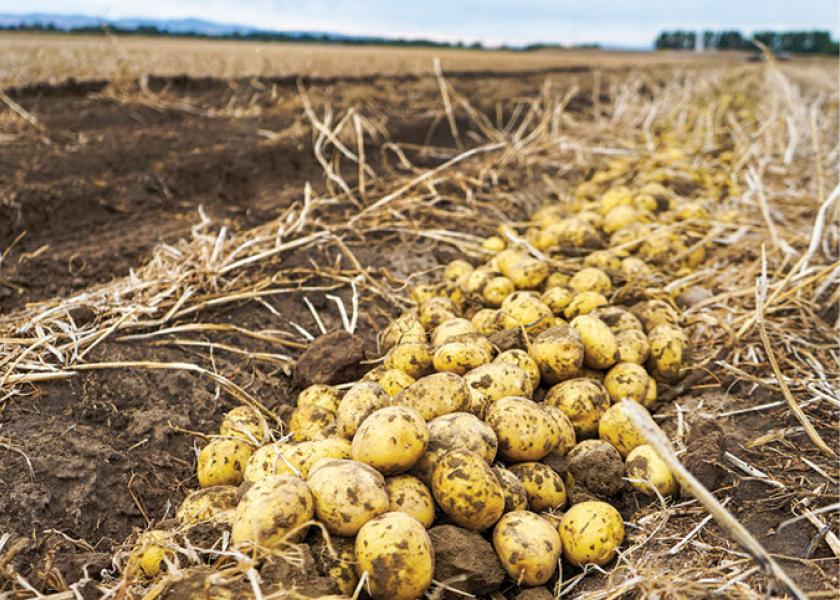Idaho potato sales find markets in spite of COVID-19 pandemic

Idaho potato sales are threading their way through the COVID-19 pandemic by spiking in retail stores, while recovering in the foodservice sector, marketers say.
“The pandemic has greatly affected retail sales, and we foresee the trend continuing into the coming year,” said Ross Johnson, international marketing director with the Eagle-based Idaho Potato Commission.
As of late September, dollar sales of potatoes were up by double digits every week since the beginning of March, when the pandemic first broke out across the U.S., Johnson said.
The commission’s retail promotion directors were meeting with retailers, helping them compare their sales to the rest of their market “to help identify areas of opportunity,” Johnson said.
“Many retailers are seeing double-digit dollar increases, but knowing potato shoppers have a higher average basket ring than any other produce shopper requires a category manager’s full attention to make sure you are winning in your market,” Johnson said.
“The IPC is currently doing what we call ‘COVID’ analyses, focusing on what shopping behavior was during pandemic buying, and how it continues to evolve as we try to beat COVID.”
Retailers can reach out to their IPC promotion director and a personalized assessment will be done to share the data’s findings, Johnson said.
Suppliers, meanwhile, have worked at answering all calls for potatoes, said Dallin Klingler, marketing and communications manager with Idaho Falls, Idaho-based Eagle Eye Produce.
“Our biggest challenge when the news about COVID-19 first hit was keeping up with retail demand,” he said. “We had potato baggers running 24-7, while grocery stores were experiencing a run on their stores.”
Foodservice sales “took a hit” as restaurants around the country were closed, Klingler noted.
That has changed, he said.
“Now that restaurants have started coming back online, we’re seeing that foodservice business stabilize,” he said.
“The demand in smaller pack styles has risen and with that uptick in packaging demand, we are seeing packaging suppliers nationwide with longer lead times and increased costs on poly and mesh bags.”
There remains “a lot of uncertainty” for the upcoming year, “but we have shown as an industry how versatile we can be during these trying times, and we’re optimistic about the future,” Klingler said.
The pandemic led to fewer plantings at Southwind Farms Inc., a Heyburn, Idaho-based fingerling grower-shipper, said Robert Tominaga, president.
“We planted 23% less yellow fingerling acres than in 2019, due to uncertainty of the long-term effects of the COVID-19 pandemic, but we think, and hope, we will still have a year-round shipping season,” he said.
The pandemic might be causing an increase in organic production, Tominaga said.
“I see more organic Idaho potatoes each year, but it is still a very small percentage,” he said.
“Until foodservice returns to near normal usage, we may be coaxed into more organic acres.”
Optimism still reigns, Tominaga noted.
“All in all, we are not out of the woods yet, but it could have been a lot worse if we had not shifted gears and focused on our retail customers,” he said.
Southwind still has fingerlings for foodservice customers, Tominaga said.
“We have not abandoned our foodservice customer by any means and have adapted in getting them smaller orders on a quicker rotation,” he said.
“Kudos to our excellent staff; we couldn’t have survived without their hard work, understanding and loyalty to our company. Our heartfelt gratitude for being there for us during this extreme unprecedented time in history.”
Sugar City, Idaho-based grower-shipper Sun-Glo of Idaho Inc. had to “flip” its production when the pandemic hit, said Jill Cox, vice president of sales.
“Obviously, our foodservice took the biggest hit,” she said. “We were fortunate that our plant was flippable.”
A surge of panic-buying in retail stores across the U.S. prompted the change, Cox said.
“We were able to put the foodservice-size potatoes in bags and distribute to grocery stores,” she said.
“We kept going and are trying to feed the people through the grocery stores instead of the restaurants.”
Foodservice sales were not back to near normal levels by early October, Cox said Oct. 3.
“We’re slowly coming back, and now, we’re kind of balanced,” she said.
The pandemic boosted sales of packaging and related materials, marketers said.
“Sales of Kwik Lok closures have increased, along with the spike in the produce industry as a whole,” said Karen Reed, marketing and communications director with Union Gap, Wash.-based closure manufacturer Kwik Lok Corp.
“We continue to work on solutions for our customers that help them be more sustainable and meet the demands of the consumer.”
The pandemic “has really shook up the produce world” in the retail area, and consumer packaging for fresh produce is “in high demand,” due to strict regulations on restaurant operations, along with “swiftly changing” consumer buying habits, said Jeff Watkin, marketing director at Collinsville, Ill.-based packaging manufacturer Sev-Rend Corp.
“Consumers are eating at home much more often now and their purchases on the retail side are higher to cut down on the frequent visits to the store,” he said.
Sev-Rend has adapted to the surge in demand, with “staying on top of raw materials for our styles of packaging” being its primary challenge, Watkin said.
“Our material purchasing team have been superstars at Sev-Rend lately, making sure there are adequate materials available so we do not see any gaps in production,” he said.
Related Content:







